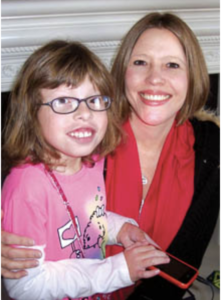**THROWBACK POST**
December 2 2010:
WooHoo Y’all! The RN&R article about Turning Views Foundation and Different iz Good came out today! Kat did a great job of condensing the ton of information I spilled out to her!
https://www.newsreview.com/reno/something-to-talk-about/content?oid=1883366
By Kat Kerlin
[email protected]
This article was published on .
Lillian Darnell holds the iPhone that, though speech impaired, allows her to talk through a special app. Her mom, Camilla Downs, stands beside her.
PHOTO BY KAT KERLIN
Lillian Darnell was 3 years old in 2004 when her mother, Camilla Downs, received a phone call from her pediatrician.
“It was a phone call that landed me in a place I never thought I’d be,” says Downs.
Lillian had been born a month early, so Downs attributed the developmental delays she’d noticed to the fact that she was a preemie. But that day, she discovered Lillian had a chromosomal abnormality, so rare it didn’t really have a name: It’s just called 18p-, a deletion of the short arm of chromosome 18.
“The main way it manifests for her is communication,” says Downs. “Everything is in her mind, she just can’t articulate it.” Lillian is about 90 percent unintelligible.
Before this year, Lillian, now 9, had been carrying around a heavy, clunky “augmented communicator” called Dynavox. She actually had to pull it on a cart behind her at recess. Then Downs heard about Proloquo2Go, an iPhone app that could do the same thing, but on a smaller and, let’s face it, cooler device. She bought Lillian an iPhone and had the app installed. Lillian carries it in her purse, which has a speaker clipped to it to make her “voice” louder. There are programmable buttons on it for typical things she might say in class or to her friends, as well as a section for things she could say in emergencies. For other things she wants to say, she can type it into the keypad and press “speak.”
The whole thing cost less than $1,000. Compare that to the $5,000-$10,000 people pay for augmented communicators. However, health insurance and Medicaid will pay for those clunky, expensive devices, but not for iPhones, iPads or iPod Touches that could have apps like Proloquo2Go installed on them.
“There’s no reason these kids should have to wait to have a modern way to communicate,” says Downs.
The school district will provide an iPod Touch or an iPad to the speech impaired, but not an iPhone, which Downs wanted Lillian to have for emergencies. So she decided to start a nonprofit, Turning Views, which encompasses the Different Iz Good movement to help kids like Lillian. Key to that is “Lillian’s Voice,” the recycling program that takes used iPodTouches, iPhones and iPads and gives them to children who are speech impaired or nonverbal. She accepts “last generation” devices, meaning more recent models, as some older ones may not be able to have the app installed on it. Look for “Lillian’s Voice” drop-off boxes at New2U Computers and Mac-O-Rama. (See column note for details.) People can also donate money or gift cards from iTunes or Apple on the nonprofit’s website, www.differentizgood.org.
“People still haven’t caught on that these are more than just phone and music devices,” says Downs. “It’s not just the app itself, but the shift that has occurred in society. It’s a communication revolution, in a way, that includes the nonverbal and speech impaired in a way they never have been before.”
What does Lillian have to say about it? She punches some keys on her phone, looks up, nods her head and presses “speak”: “I like the iPhone.”

